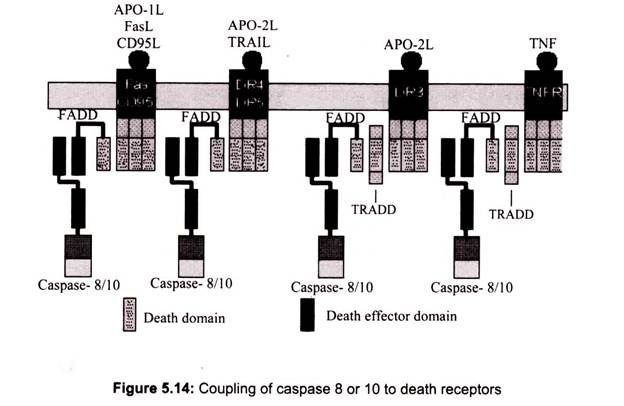After reading this article you will learn about the process of apoptosis which is characterised by chromatin condensation, with the help of suitable diagrams.
Apoptosis, the programmed cell death is characterized by chromatin condensation and cell shrinkage in the early stage and then the nucleus and cytoplasm fragment, forming membrane-bound apoptotic bodies which can be engulfed by phagocytes. In contrast, cells undergo another form of cell death, necrosis, swell and rupture. The released intracellular contents can damage surrounding cells and often cause inflammation. Apoptosis is an important process during normal development. It also involved in aging and various diseases such as cancer, AIDS, Alzheimer’s disease and Parkinson’s disease.
Programmed cell death, or apoptosis, is mediated by proteolytic enzymes called caspases, which are synthesized in the precursor forms as procaspases. When activated by various signals, caspases function to cause cell death in most organisms, ranging from C. elegans to human beings. Apoptosis provides a means deciding the shapes of body parts in the course of development and a means of eliminating cells producing anti-self antibodies or infected with pathogens as well as cells containing large amounts of damaged DNA. Cytotoxic T cells initiate apoptosis in cells to which they bind through T-cell receptor-class I MHC-peptide interactions aided by interactions with the coreceptor molecule CD8.
Under some circumstances, such as when DNA damage is extensive, p53 also activates expression of genes that lead to apoptosis, the process of programmed cell death that normally occurs in specific cells during the development of multicellular animals. In vertebrates, the p53 response evolved to induce apoptosis in the face of extensive DNA damage, presumably to prevent the accumulation of multiple mutations that might convert a normal cell into a cancer cell.
During apoptosis, the cell is digested by a class of proteases called caspases. More than 10 caspases have been identified. Some of them (e.g., caspase 8 and 10) are involved in the initiation of apoptosis, others (caspase 3, 6, and 7) execute the death order by destroying essential proteins in the cell (Fig. 5.13).
The apoptotic process can be summarized as follows:
i. Activation of initiating caspases by specific signals.
ii. Activation of executing caspases by the initiating caspases which can cleave inactive caspases at specific sites.
iii. Degradation of essential cellular proteins by the executing caspases with their protease
iv. Death receptors- Fas/CD95, DR4/DR5, DR3, and TNFR (Tumor Necrosis Factor Receptor).
v. Adaptors- FADD (Fas-associated death domain protein) and TRADD (TNFR-associated death domain protein).
vi. Activation- Binding of death ligands (FasL/CD95L, TRAIL/APO-2L, APO-3L and TNF) induces trimerization of their receptors, which then recruit adaptors and subsequently activate the caspases (Fig. 5.14).

